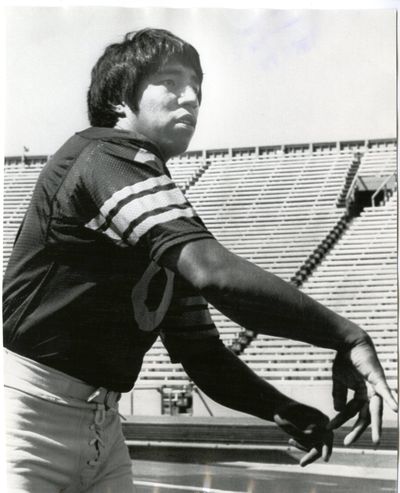Sixkiller admires Wilson
Former Huskies QB heard same tired cliches

Growing up in Ashland, Ore., all-state in three sports, Sonny Sixkiller’s wish was to stay close to home and play quarterback for Dee Andros at Oregon State.
Sixkiller was fast and smart and threw the kind of hard, tight, accurate spiral that every kid on every playground wished he could throw. He was a college quarterback in the making.
There only was one problem. Sixkiller stood 5 feet 10 and weighed a mere 155 pounds and, even in the late 1960s and early ’70s, coaches liked their quarterbacks to be prototypes, tall enough to stand in the pocket and see over the line of scrimmage and find their receivers.
Most coaches, general managers, scouts and recruiters believe in stereotypes. The catch phrase today at combine camps is “measureables.” Sixkiller was, um, short on some of those measureables, so Andros suggested he play at a nearby junior college.
“Maybe in a couple of years, you’ll grow a little bit,” Andros told him. Really? “In high school I never thought about my height,” Sixkiller said. “It was just who I was.” Only Washington’s head coach, Jim Owens, and the Huskies’ former Rose Bowl-winning quarterback, Bob Schloredt, stayed on Sixkiller. Even Owens was a little skeptical.
As they walked to the car after their home recruiting visit to Ashland, Owens poked Schloredt in the ribs and asked, “Is that kid ever going to grow?”
“I don’t care,” Schloredt told him. “The kid can throw the rock.” Sound familiar? More than four decades before Russell Wilson came to the Seattle Seahawks, there was a quarterback in town named Sonny Sixkiller.
He was the first quarterback in Seattle to beat the size stereotype. Sixkiller, who grew about an inch after he came to Washington, heard all of the same clichés as Wilson. He fielded the same questions from coaches and writers, who believed that size mattered.
Wilson and Sixkiller are kindred spirits. “I was really impressed with him last year when he played at Wisconsin,” Sixkiller said of Wilson. “I didn’t care about his size. I liked the way he handled himself. I thought he could be a really good pro if he got with the right team.”
There are similarities between Sixkiller and Wilson that are more important than their stature. They both understand winning. They both were accomplished baseball players. And both helped resurrect moribund programs.
Before Wilson arrived in April, the Seahawks had suffered four consecutive losing seasons. If they beat St. Louis at home Sunday they will finish with 11 wins, the third-best season in team history.
Washington was 1-9 in 1969, the year before Sixkiller became the quarterback. The Huskies were 6-4 his first season, when Sixkiller led the nation in passing. They were 22-10 in the Sixkiller years.
For Sixkiller and Wilson, becoming a quarterback was more about want and will than feet and inches. “I wanted to put in the work,” Sixkiller said. “I was willing to work hard in practice to overcome the height problem.”
Washington’s quarterbacks coach, Jerry Cheek, created a drill, constructing a 10-foot high replica of a glove and placing it at the line of scrimmage, then ordering Sixkiller to take his normal drop and throw over the glove.
“It really helped me work on that high point of my release as I was dropping back and throwing the ball over the middle,” he said. “It helped a lot with my technique. The other day I read about how Russell Wilson watches his follow-through on film, seeing where his point of release is, and it brought back a lot of memories. We used to work on that so much.”
Sixkiller joked that he never was a 6-foot-5 quarterback, so he has no other reference point. Like Wilson, he became a student of the position and he never accepted other people’s stereotyping.
“When I look back on it, there were always creases created from the way defensive guys were rushing toward you,” said Sixkiller, whose first center at Washington was 6-foot-7 Bruce Jarvis. “The pocket moved. You found the creases. You read your keys, so you kind of knew where guys were going to be.”
You trust your athleticism. You put in the extra time. You study the position, refine your technique. And you don’t pay attention to the legions who don’t understand all that’s inside of you.
Sonny Sixkiller and Russell Wilson didn’t set the odds. They just beat them.